Advanced Financial Accounting Report: New Hope & Lease Standards
VerifiedAdded on 2020/05/28
|12
|2711
|48
Report
AI Summary
This report analyzes advanced financial accounting concepts, focusing on impairment testing and lease accounting based on the financial statements of New Hope Group Limited and the impact of new accounting standards, particularly concerning leases. The report addresses impairment testing methodologies, including the assessment of recoverable amounts, the use of discounted cash flow models, and the role of management judgment in estimating asset values. It explores the subjectivity involved in impairment testing and its implications for financial reporting users. The report also examines the criticisms of previous lease accounting standards, which did not mandate the disclosure of operating leases on the balance sheet, and the impact of the new lease standard on financial statements. It discusses the reasons for the unpopularity of the new standard, the changes it brings to financial ratios, and the implications for companies with significant operating leases. Furthermore, the report highlights the benefits of the new standard, such as improved transparency, enhanced comparability between companies, and a more accurate reflection of lease obligations on the balance sheet.
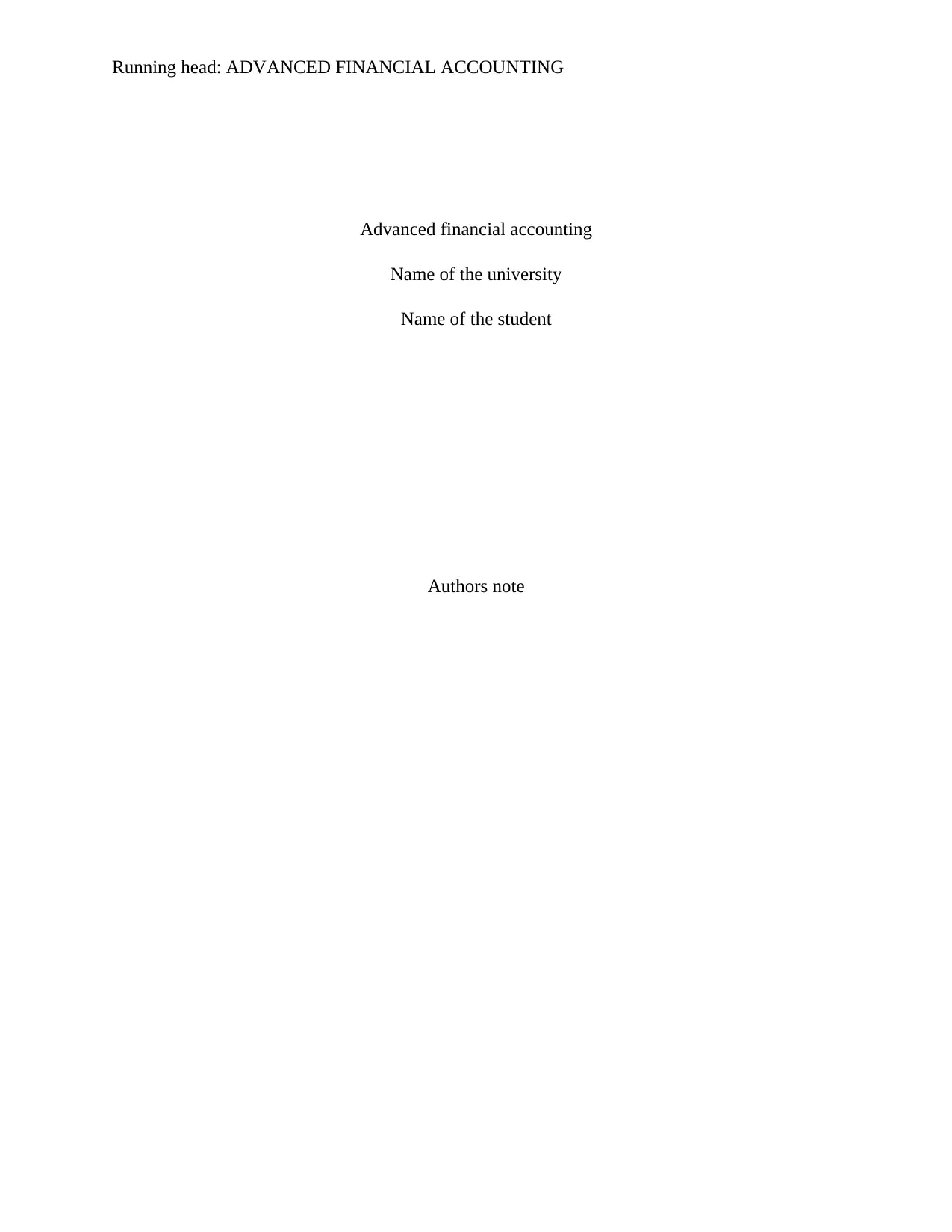
Running head: ADVANCED FINANCIAL ACCOUNTING
Advanced financial accounting
Name of the university
Name of the student
Authors note
Advanced financial accounting
Name of the university
Name of the student
Authors note
Paraphrase This Document
Need a fresh take? Get an instant paraphrase of this document with our AI Paraphraser
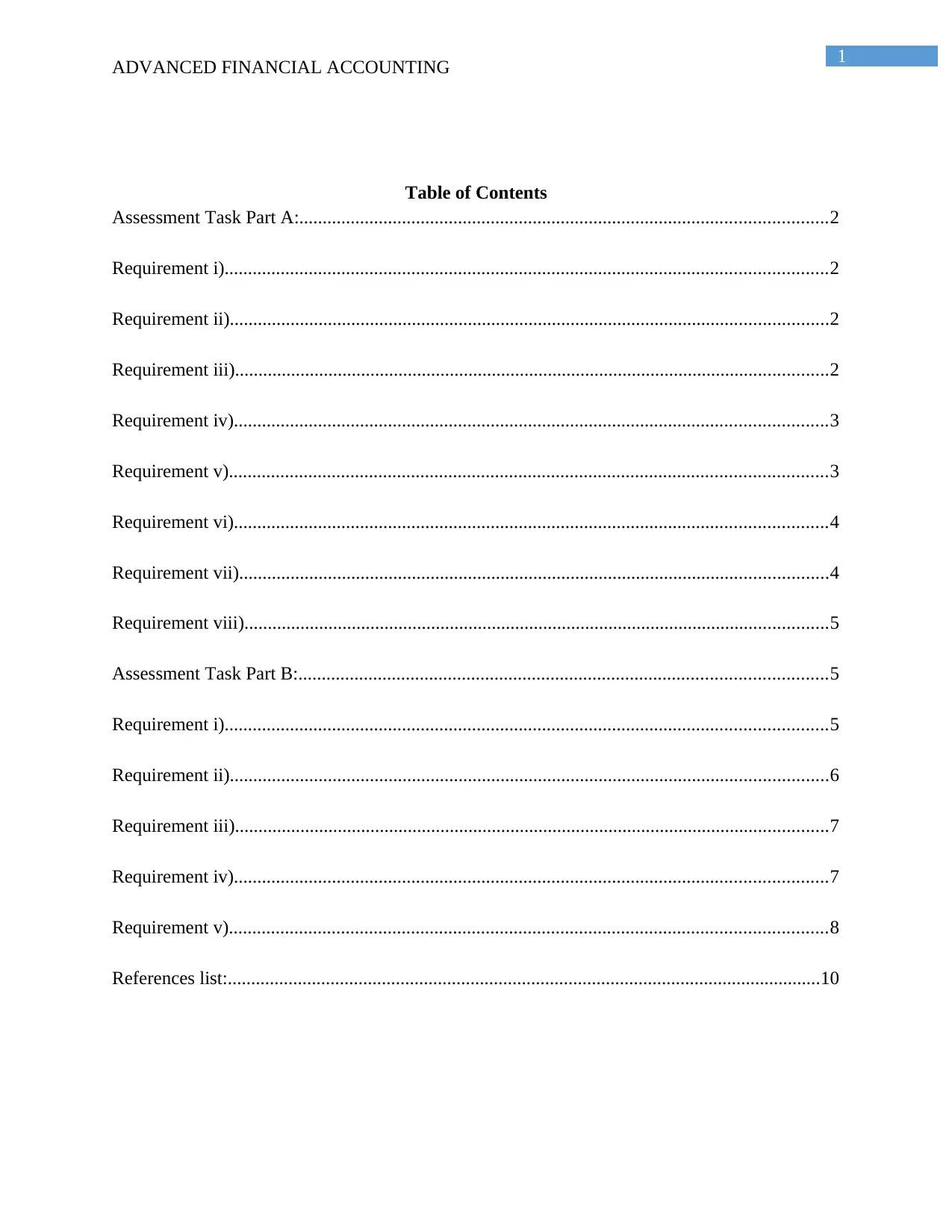
1
ADVANCED FINANCIAL ACCOUNTING
Table of Contents
Assessment Task Part A:.................................................................................................................2
Requirement i).................................................................................................................................2
Requirement ii)................................................................................................................................2
Requirement iii)...............................................................................................................................2
Requirement iv)...............................................................................................................................3
Requirement v)................................................................................................................................3
Requirement vi)...............................................................................................................................4
Requirement vii)..............................................................................................................................4
Requirement viii).............................................................................................................................5
Assessment Task Part B:.................................................................................................................5
Requirement i).................................................................................................................................5
Requirement ii)................................................................................................................................6
Requirement iii)...............................................................................................................................7
Requirement iv)...............................................................................................................................7
Requirement v)................................................................................................................................8
References list:...............................................................................................................................10
ADVANCED FINANCIAL ACCOUNTING
Table of Contents
Assessment Task Part A:.................................................................................................................2
Requirement i).................................................................................................................................2
Requirement ii)................................................................................................................................2
Requirement iii)...............................................................................................................................2
Requirement iv)...............................................................................................................................3
Requirement v)................................................................................................................................3
Requirement vi)...............................................................................................................................4
Requirement vii)..............................................................................................................................4
Requirement viii).............................................................................................................................5
Assessment Task Part B:.................................................................................................................5
Requirement i).................................................................................................................................5
Requirement ii)................................................................................................................................6
Requirement iii)...............................................................................................................................7
Requirement iv)...............................................................................................................................7
Requirement v)................................................................................................................................8
References list:...............................................................................................................................10
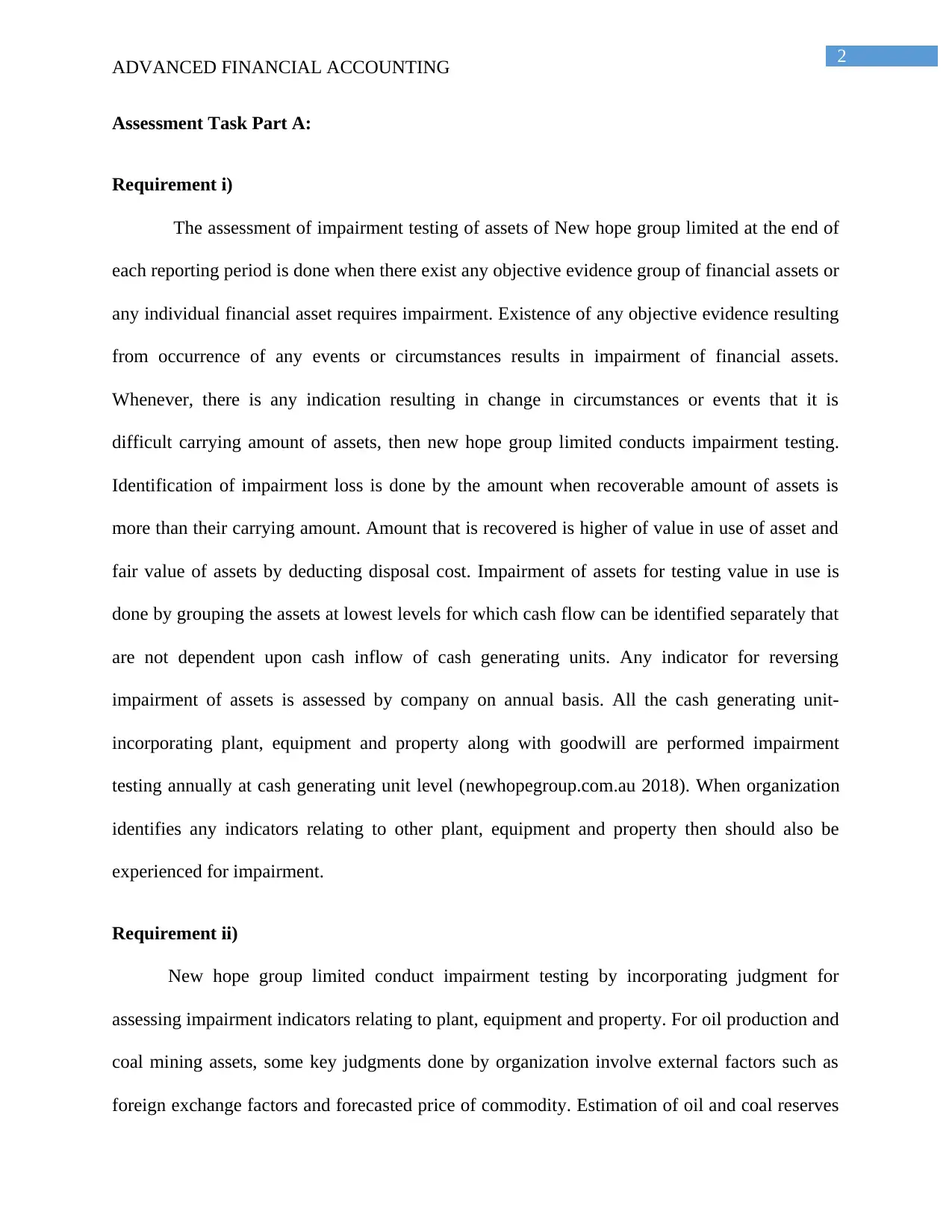
2
ADVANCED FINANCIAL ACCOUNTING
Assessment Task Part A:
Requirement i)
The assessment of impairment testing of assets of New hope group limited at the end of
each reporting period is done when there exist any objective evidence group of financial assets or
any individual financial asset requires impairment. Existence of any objective evidence resulting
from occurrence of any events or circumstances results in impairment of financial assets.
Whenever, there is any indication resulting in change in circumstances or events that it is
difficult carrying amount of assets, then new hope group limited conducts impairment testing.
Identification of impairment loss is done by the amount when recoverable amount of assets is
more than their carrying amount. Amount that is recovered is higher of value in use of asset and
fair value of assets by deducting disposal cost. Impairment of assets for testing value in use is
done by grouping the assets at lowest levels for which cash flow can be identified separately that
are not dependent upon cash inflow of cash generating units. Any indicator for reversing
impairment of assets is assessed by company on annual basis. All the cash generating unit-
incorporating plant, equipment and property along with goodwill are performed impairment
testing annually at cash generating unit level (newhopegroup.com.au 2018). When organization
identifies any indicators relating to other plant, equipment and property then should also be
experienced for impairment.
Requirement ii)
New hope group limited conduct impairment testing by incorporating judgment for
assessing impairment indicators relating to plant, equipment and property. For oil production and
coal mining assets, some key judgments done by organization involve external factors such as
foreign exchange factors and forecasted price of commodity. Estimation of oil and coal reserves
ADVANCED FINANCIAL ACCOUNTING
Assessment Task Part A:
Requirement i)
The assessment of impairment testing of assets of New hope group limited at the end of
each reporting period is done when there exist any objective evidence group of financial assets or
any individual financial asset requires impairment. Existence of any objective evidence resulting
from occurrence of any events or circumstances results in impairment of financial assets.
Whenever, there is any indication resulting in change in circumstances or events that it is
difficult carrying amount of assets, then new hope group limited conducts impairment testing.
Identification of impairment loss is done by the amount when recoverable amount of assets is
more than their carrying amount. Amount that is recovered is higher of value in use of asset and
fair value of assets by deducting disposal cost. Impairment of assets for testing value in use is
done by grouping the assets at lowest levels for which cash flow can be identified separately that
are not dependent upon cash inflow of cash generating units. Any indicator for reversing
impairment of assets is assessed by company on annual basis. All the cash generating unit-
incorporating plant, equipment and property along with goodwill are performed impairment
testing annually at cash generating unit level (newhopegroup.com.au 2018). When organization
identifies any indicators relating to other plant, equipment and property then should also be
experienced for impairment.
Requirement ii)
New hope group limited conduct impairment testing by incorporating judgment for
assessing impairment indicators relating to plant, equipment and property. For oil production and
coal mining assets, some key judgments done by organization involve external factors such as
foreign exchange factors and forecasted price of commodity. Estimation of oil and coal reserves
⊘ This is a preview!⊘
Do you want full access?
Subscribe today to unlock all pages.

Trusted by 1+ million students worldwide
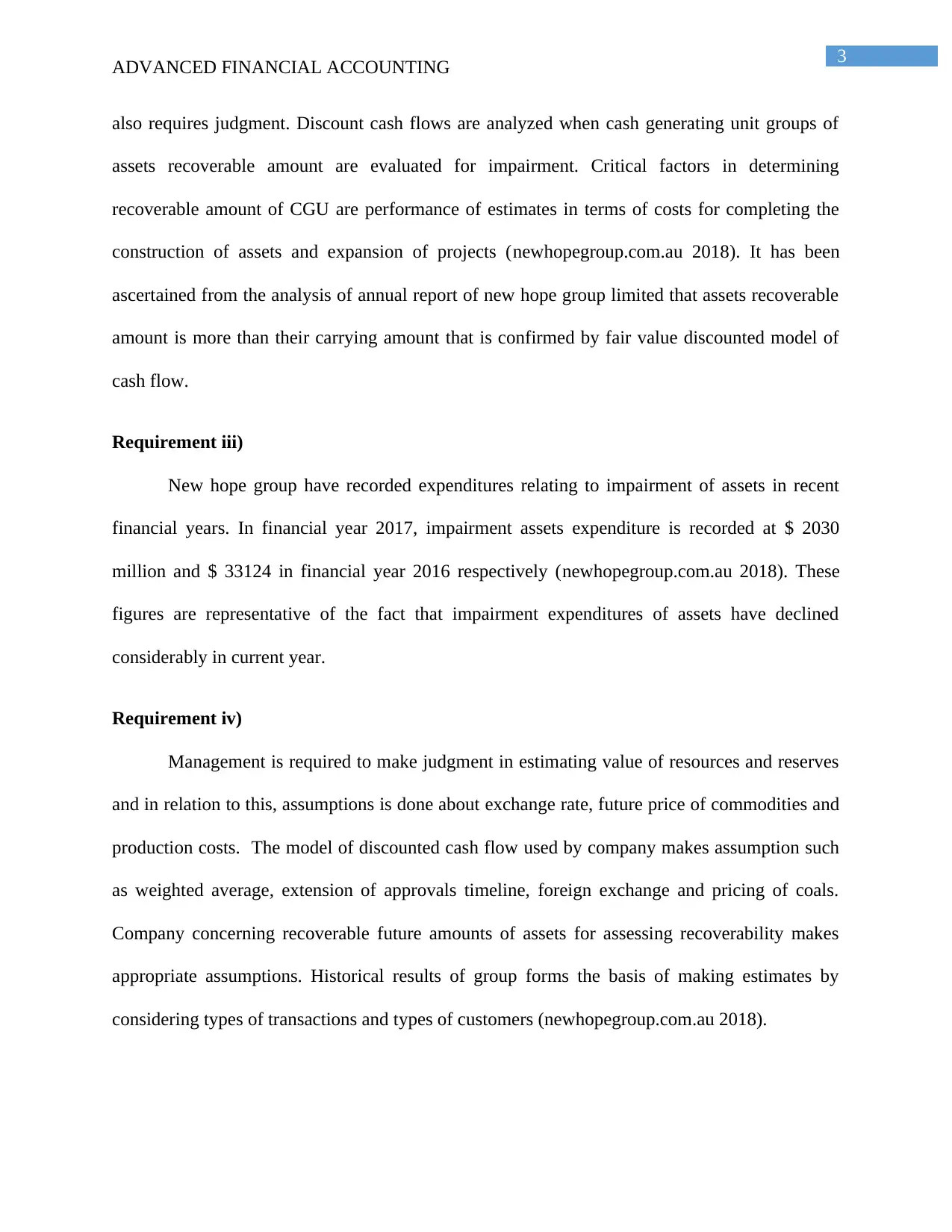
3
ADVANCED FINANCIAL ACCOUNTING
also requires judgment. Discount cash flows are analyzed when cash generating unit groups of
assets recoverable amount are evaluated for impairment. Critical factors in determining
recoverable amount of CGU are performance of estimates in terms of costs for completing the
construction of assets and expansion of projects (newhopegroup.com.au 2018). It has been
ascertained from the analysis of annual report of new hope group limited that assets recoverable
amount is more than their carrying amount that is confirmed by fair value discounted model of
cash flow.
Requirement iii)
New hope group have recorded expenditures relating to impairment of assets in recent
financial years. In financial year 2017, impairment assets expenditure is recorded at $ 2030
million and $ 33124 in financial year 2016 respectively (newhopegroup.com.au 2018). These
figures are representative of the fact that impairment expenditures of assets have declined
considerably in current year.
Requirement iv)
Management is required to make judgment in estimating value of resources and reserves
and in relation to this, assumptions is done about exchange rate, future price of commodities and
production costs. The model of discounted cash flow used by company makes assumption such
as weighted average, extension of approvals timeline, foreign exchange and pricing of coals.
Company concerning recoverable future amounts of assets for assessing recoverability makes
appropriate assumptions. Historical results of group forms the basis of making estimates by
considering types of transactions and types of customers (newhopegroup.com.au 2018).
ADVANCED FINANCIAL ACCOUNTING
also requires judgment. Discount cash flows are analyzed when cash generating unit groups of
assets recoverable amount are evaluated for impairment. Critical factors in determining
recoverable amount of CGU are performance of estimates in terms of costs for completing the
construction of assets and expansion of projects (newhopegroup.com.au 2018). It has been
ascertained from the analysis of annual report of new hope group limited that assets recoverable
amount is more than their carrying amount that is confirmed by fair value discounted model of
cash flow.
Requirement iii)
New hope group have recorded expenditures relating to impairment of assets in recent
financial years. In financial year 2017, impairment assets expenditure is recorded at $ 2030
million and $ 33124 in financial year 2016 respectively (newhopegroup.com.au 2018). These
figures are representative of the fact that impairment expenditures of assets have declined
considerably in current year.
Requirement iv)
Management is required to make judgment in estimating value of resources and reserves
and in relation to this, assumptions is done about exchange rate, future price of commodities and
production costs. The model of discounted cash flow used by company makes assumption such
as weighted average, extension of approvals timeline, foreign exchange and pricing of coals.
Company concerning recoverable future amounts of assets for assessing recoverability makes
appropriate assumptions. Historical results of group forms the basis of making estimates by
considering types of transactions and types of customers (newhopegroup.com.au 2018).
Paraphrase This Document
Need a fresh take? Get an instant paraphrase of this document with our AI Paraphraser
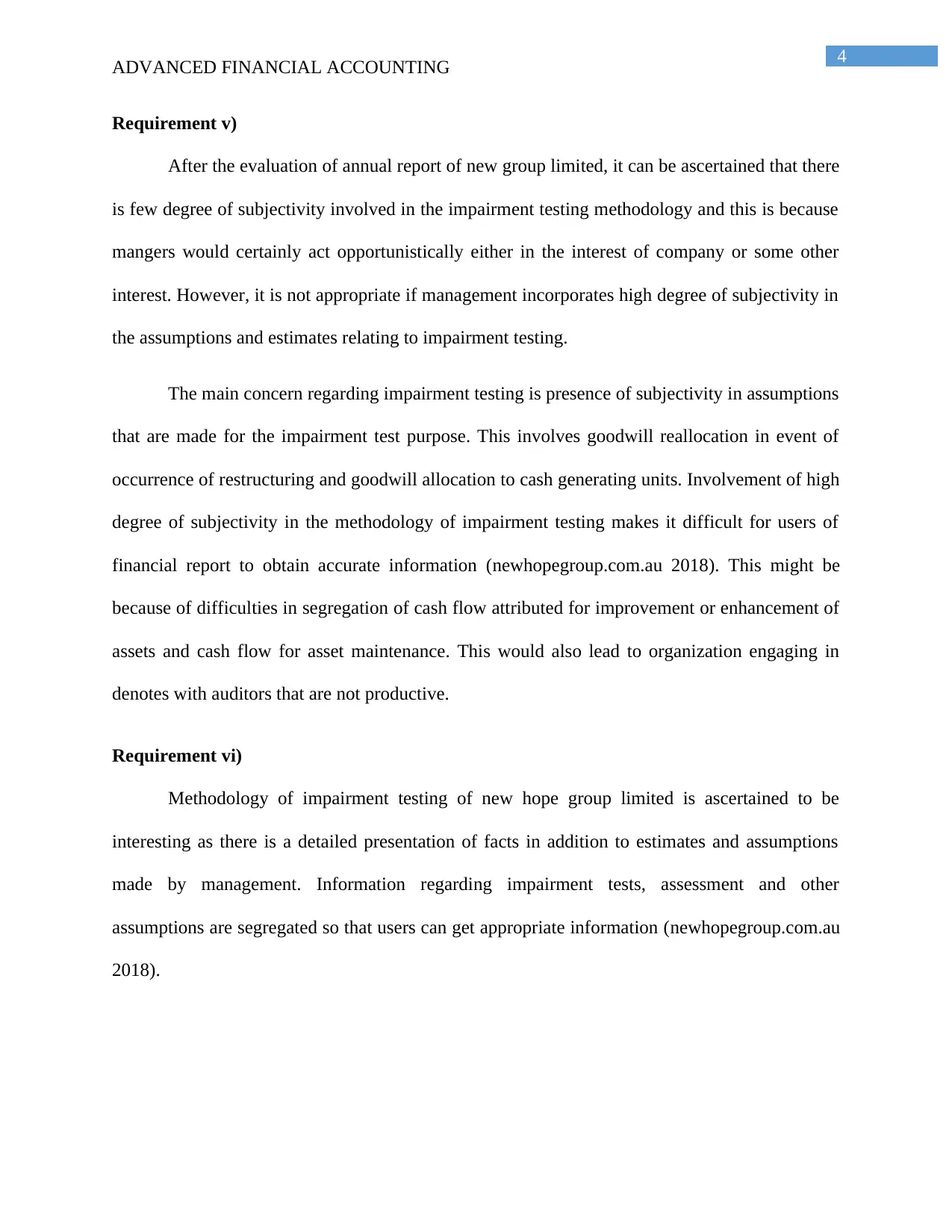
4
ADVANCED FINANCIAL ACCOUNTING
Requirement v)
After the evaluation of annual report of new group limited, it can be ascertained that there
is few degree of subjectivity involved in the impairment testing methodology and this is because
mangers would certainly act opportunistically either in the interest of company or some other
interest. However, it is not appropriate if management incorporates high degree of subjectivity in
the assumptions and estimates relating to impairment testing.
The main concern regarding impairment testing is presence of subjectivity in assumptions
that are made for the impairment test purpose. This involves goodwill reallocation in event of
occurrence of restructuring and goodwill allocation to cash generating units. Involvement of high
degree of subjectivity in the methodology of impairment testing makes it difficult for users of
financial report to obtain accurate information (newhopegroup.com.au 2018). This might be
because of difficulties in segregation of cash flow attributed for improvement or enhancement of
assets and cash flow for asset maintenance. This would also lead to organization engaging in
denotes with auditors that are not productive.
Requirement vi)
Methodology of impairment testing of new hope group limited is ascertained to be
interesting as there is a detailed presentation of facts in addition to estimates and assumptions
made by management. Information regarding impairment tests, assessment and other
assumptions are segregated so that users can get appropriate information (newhopegroup.com.au
2018).
ADVANCED FINANCIAL ACCOUNTING
Requirement v)
After the evaluation of annual report of new group limited, it can be ascertained that there
is few degree of subjectivity involved in the impairment testing methodology and this is because
mangers would certainly act opportunistically either in the interest of company or some other
interest. However, it is not appropriate if management incorporates high degree of subjectivity in
the assumptions and estimates relating to impairment testing.
The main concern regarding impairment testing is presence of subjectivity in assumptions
that are made for the impairment test purpose. This involves goodwill reallocation in event of
occurrence of restructuring and goodwill allocation to cash generating units. Involvement of high
degree of subjectivity in the methodology of impairment testing makes it difficult for users of
financial report to obtain accurate information (newhopegroup.com.au 2018). This might be
because of difficulties in segregation of cash flow attributed for improvement or enhancement of
assets and cash flow for asset maintenance. This would also lead to organization engaging in
denotes with auditors that are not productive.
Requirement vi)
Methodology of impairment testing of new hope group limited is ascertained to be
interesting as there is a detailed presentation of facts in addition to estimates and assumptions
made by management. Information regarding impairment tests, assessment and other
assumptions are segregated so that users can get appropriate information (newhopegroup.com.au
2018).
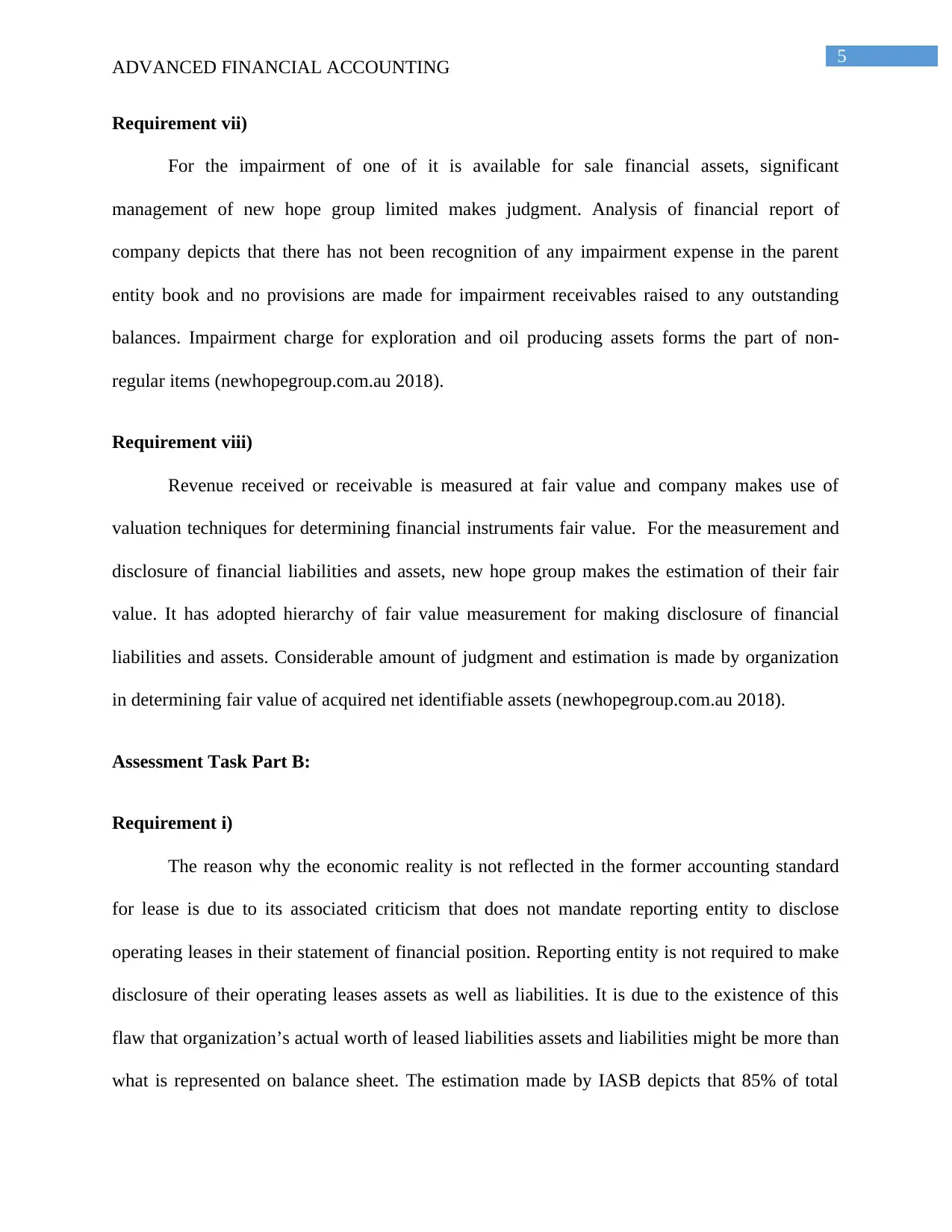
5
ADVANCED FINANCIAL ACCOUNTING
Requirement vii)
For the impairment of one of it is available for sale financial assets, significant
management of new hope group limited makes judgment. Analysis of financial report of
company depicts that there has not been recognition of any impairment expense in the parent
entity book and no provisions are made for impairment receivables raised to any outstanding
balances. Impairment charge for exploration and oil producing assets forms the part of non-
regular items (newhopegroup.com.au 2018).
Requirement viii)
Revenue received or receivable is measured at fair value and company makes use of
valuation techniques for determining financial instruments fair value. For the measurement and
disclosure of financial liabilities and assets, new hope group makes the estimation of their fair
value. It has adopted hierarchy of fair value measurement for making disclosure of financial
liabilities and assets. Considerable amount of judgment and estimation is made by organization
in determining fair value of acquired net identifiable assets (newhopegroup.com.au 2018).
Assessment Task Part B:
Requirement i)
The reason why the economic reality is not reflected in the former accounting standard
for lease is due to its associated criticism that does not mandate reporting entity to disclose
operating leases in their statement of financial position. Reporting entity is not required to make
disclosure of their operating leases assets as well as liabilities. It is due to the existence of this
flaw that organization’s actual worth of leased liabilities assets and liabilities might be more than
what is represented on balance sheet. The estimation made by IASB depicts that 85% of total
ADVANCED FINANCIAL ACCOUNTING
Requirement vii)
For the impairment of one of it is available for sale financial assets, significant
management of new hope group limited makes judgment. Analysis of financial report of
company depicts that there has not been recognition of any impairment expense in the parent
entity book and no provisions are made for impairment receivables raised to any outstanding
balances. Impairment charge for exploration and oil producing assets forms the part of non-
regular items (newhopegroup.com.au 2018).
Requirement viii)
Revenue received or receivable is measured at fair value and company makes use of
valuation techniques for determining financial instruments fair value. For the measurement and
disclosure of financial liabilities and assets, new hope group makes the estimation of their fair
value. It has adopted hierarchy of fair value measurement for making disclosure of financial
liabilities and assets. Considerable amount of judgment and estimation is made by organization
in determining fair value of acquired net identifiable assets (newhopegroup.com.au 2018).
Assessment Task Part B:
Requirement i)
The reason why the economic reality is not reflected in the former accounting standard
for lease is due to its associated criticism that does not mandate reporting entity to disclose
operating leases in their statement of financial position. Reporting entity is not required to make
disclosure of their operating leases assets as well as liabilities. It is due to the existence of this
flaw that organization’s actual worth of leased liabilities assets and liabilities might be more than
what is represented on balance sheet. The estimation made by IASB depicts that 85% of total
⊘ This is a preview!⊘
Do you want full access?
Subscribe today to unlock all pages.

Trusted by 1+ million students worldwide
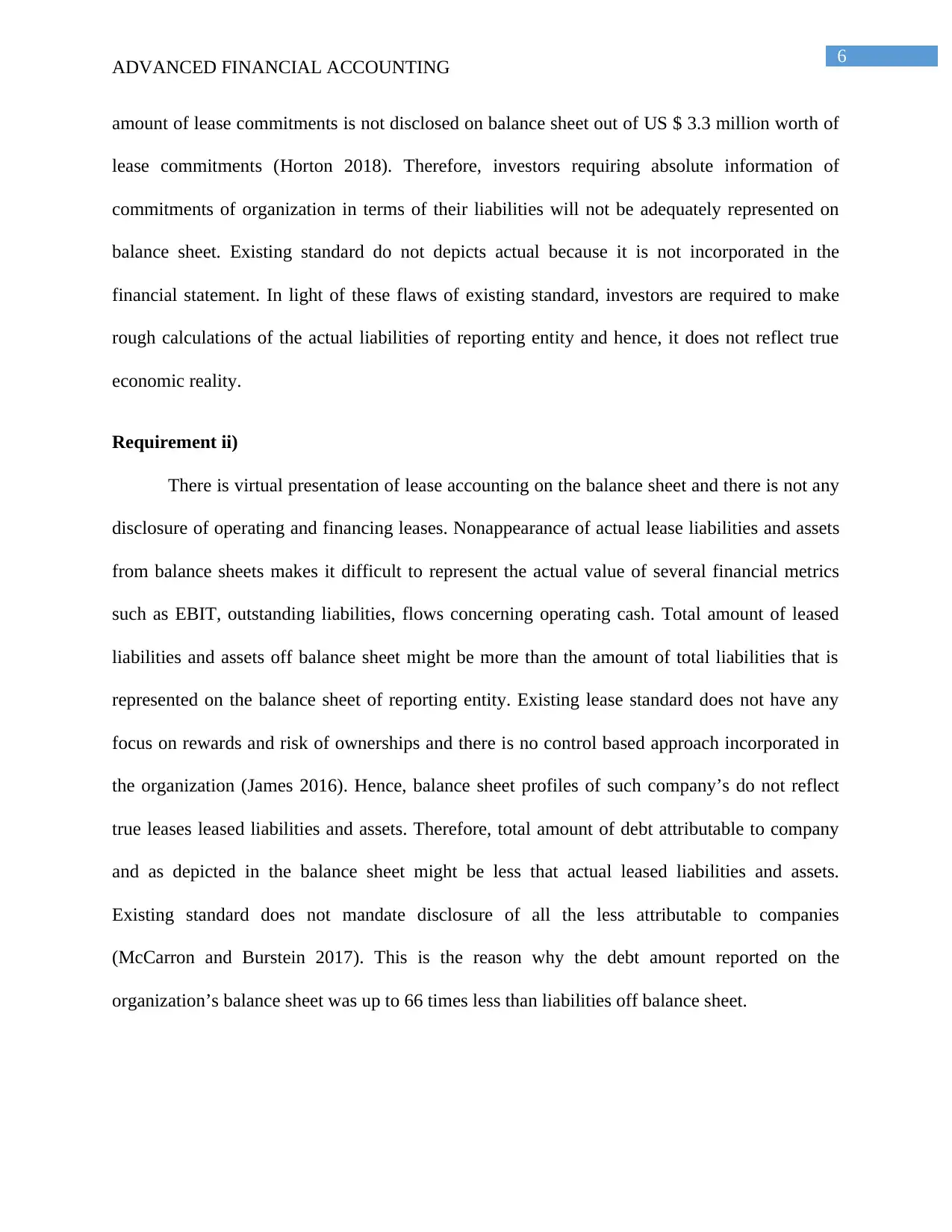
6
ADVANCED FINANCIAL ACCOUNTING
amount of lease commitments is not disclosed on balance sheet out of US $ 3.3 million worth of
lease commitments (Horton 2018). Therefore, investors requiring absolute information of
commitments of organization in terms of their liabilities will not be adequately represented on
balance sheet. Existing standard do not depicts actual because it is not incorporated in the
financial statement. In light of these flaws of existing standard, investors are required to make
rough calculations of the actual liabilities of reporting entity and hence, it does not reflect true
economic reality.
Requirement ii)
There is virtual presentation of lease accounting on the balance sheet and there is not any
disclosure of operating and financing leases. Nonappearance of actual lease liabilities and assets
from balance sheets makes it difficult to represent the actual value of several financial metrics
such as EBIT, outstanding liabilities, flows concerning operating cash. Total amount of leased
liabilities and assets off balance sheet might be more than the amount of total liabilities that is
represented on the balance sheet of reporting entity. Existing lease standard does not have any
focus on rewards and risk of ownerships and there is no control based approach incorporated in
the organization (James 2016). Hence, balance sheet profiles of such company’s do not reflect
true leases leased liabilities and assets. Therefore, total amount of debt attributable to company
and as depicted in the balance sheet might be less that actual leased liabilities and assets.
Existing standard does not mandate disclosure of all the less attributable to companies
(McCarron and Burstein 2017). This is the reason why the debt amount reported on the
organization’s balance sheet was up to 66 times less than liabilities off balance sheet.
ADVANCED FINANCIAL ACCOUNTING
amount of lease commitments is not disclosed on balance sheet out of US $ 3.3 million worth of
lease commitments (Horton 2018). Therefore, investors requiring absolute information of
commitments of organization in terms of their liabilities will not be adequately represented on
balance sheet. Existing standard do not depicts actual because it is not incorporated in the
financial statement. In light of these flaws of existing standard, investors are required to make
rough calculations of the actual liabilities of reporting entity and hence, it does not reflect true
economic reality.
Requirement ii)
There is virtual presentation of lease accounting on the balance sheet and there is not any
disclosure of operating and financing leases. Nonappearance of actual lease liabilities and assets
from balance sheets makes it difficult to represent the actual value of several financial metrics
such as EBIT, outstanding liabilities, flows concerning operating cash. Total amount of leased
liabilities and assets off balance sheet might be more than the amount of total liabilities that is
represented on the balance sheet of reporting entity. Existing lease standard does not have any
focus on rewards and risk of ownerships and there is no control based approach incorporated in
the organization (James 2016). Hence, balance sheet profiles of such company’s do not reflect
true leases leased liabilities and assets. Therefore, total amount of debt attributable to company
and as depicted in the balance sheet might be less that actual leased liabilities and assets.
Existing standard does not mandate disclosure of all the less attributable to companies
(McCarron and Burstein 2017). This is the reason why the debt amount reported on the
organization’s balance sheet was up to 66 times less than liabilities off balance sheet.
Paraphrase This Document
Need a fresh take? Get an instant paraphrase of this document with our AI Paraphraser
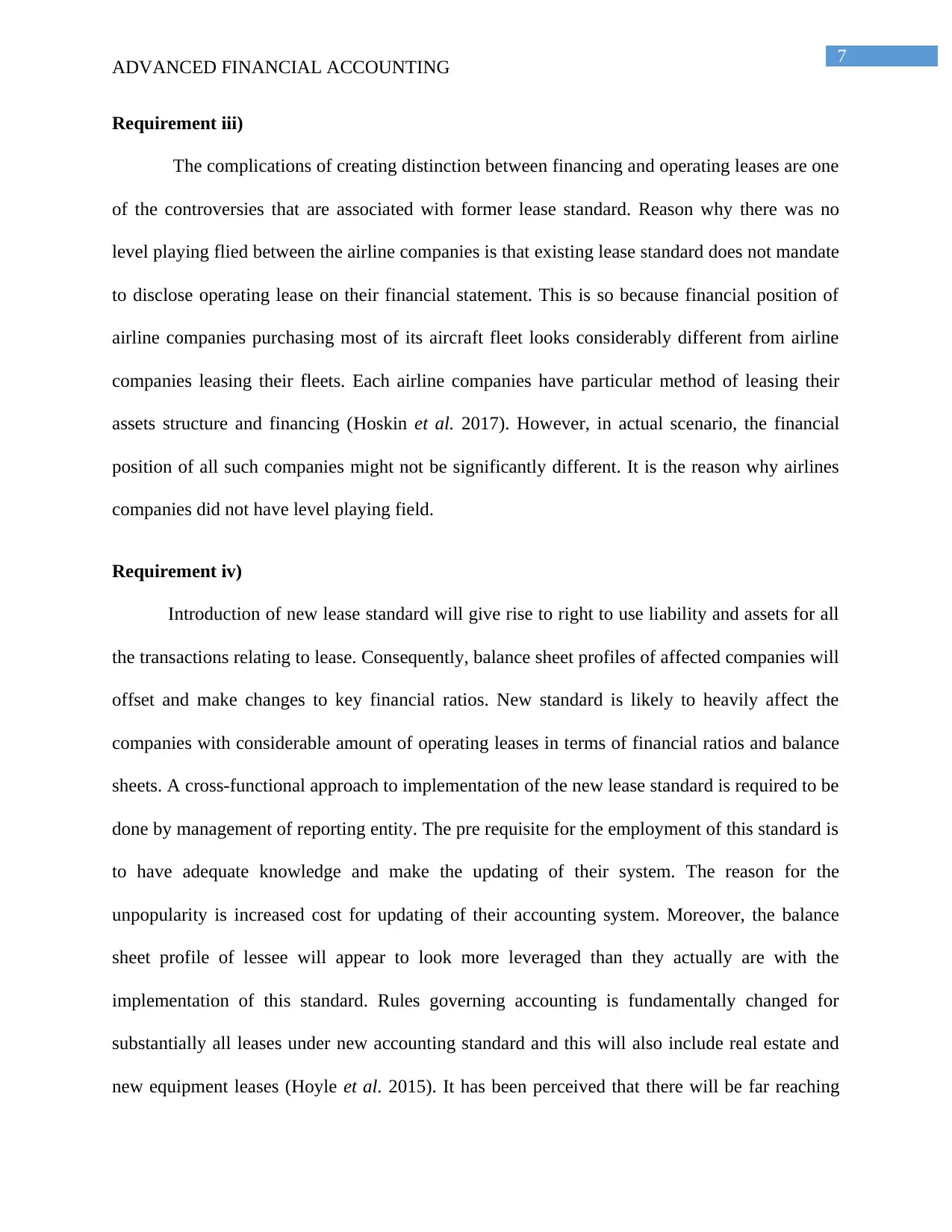
7
ADVANCED FINANCIAL ACCOUNTING
Requirement iii)
The complications of creating distinction between financing and operating leases are one
of the controversies that are associated with former lease standard. Reason why there was no
level playing flied between the airline companies is that existing lease standard does not mandate
to disclose operating lease on their financial statement. This is so because financial position of
airline companies purchasing most of its aircraft fleet looks considerably different from airline
companies leasing their fleets. Each airline companies have particular method of leasing their
assets structure and financing (Hoskin et al. 2017). However, in actual scenario, the financial
position of all such companies might not be significantly different. It is the reason why airlines
companies did not have level playing field.
Requirement iv)
Introduction of new lease standard will give rise to right to use liability and assets for all
the transactions relating to lease. Consequently, balance sheet profiles of affected companies will
offset and make changes to key financial ratios. New standard is likely to heavily affect the
companies with considerable amount of operating leases in terms of financial ratios and balance
sheets. A cross-functional approach to implementation of the new lease standard is required to be
done by management of reporting entity. The pre requisite for the employment of this standard is
to have adequate knowledge and make the updating of their system. The reason for the
unpopularity is increased cost for updating of their accounting system. Moreover, the balance
sheet profile of lessee will appear to look more leveraged than they actually are with the
implementation of this standard. Rules governing accounting is fundamentally changed for
substantially all leases under new accounting standard and this will also include real estate and
new equipment leases (Hoyle et al. 2015). It has been perceived that there will be far reaching
ADVANCED FINANCIAL ACCOUNTING
Requirement iii)
The complications of creating distinction between financing and operating leases are one
of the controversies that are associated with former lease standard. Reason why there was no
level playing flied between the airline companies is that existing lease standard does not mandate
to disclose operating lease on their financial statement. This is so because financial position of
airline companies purchasing most of its aircraft fleet looks considerably different from airline
companies leasing their fleets. Each airline companies have particular method of leasing their
assets structure and financing (Hoskin et al. 2017). However, in actual scenario, the financial
position of all such companies might not be significantly different. It is the reason why airlines
companies did not have level playing field.
Requirement iv)
Introduction of new lease standard will give rise to right to use liability and assets for all
the transactions relating to lease. Consequently, balance sheet profiles of affected companies will
offset and make changes to key financial ratios. New standard is likely to heavily affect the
companies with considerable amount of operating leases in terms of financial ratios and balance
sheets. A cross-functional approach to implementation of the new lease standard is required to be
done by management of reporting entity. The pre requisite for the employment of this standard is
to have adequate knowledge and make the updating of their system. The reason for the
unpopularity is increased cost for updating of their accounting system. Moreover, the balance
sheet profile of lessee will appear to look more leveraged than they actually are with the
implementation of this standard. Rules governing accounting is fundamentally changed for
substantially all leases under new accounting standard and this will also include real estate and
new equipment leases (Hoyle et al. 2015). It has been perceived that there will be far reaching
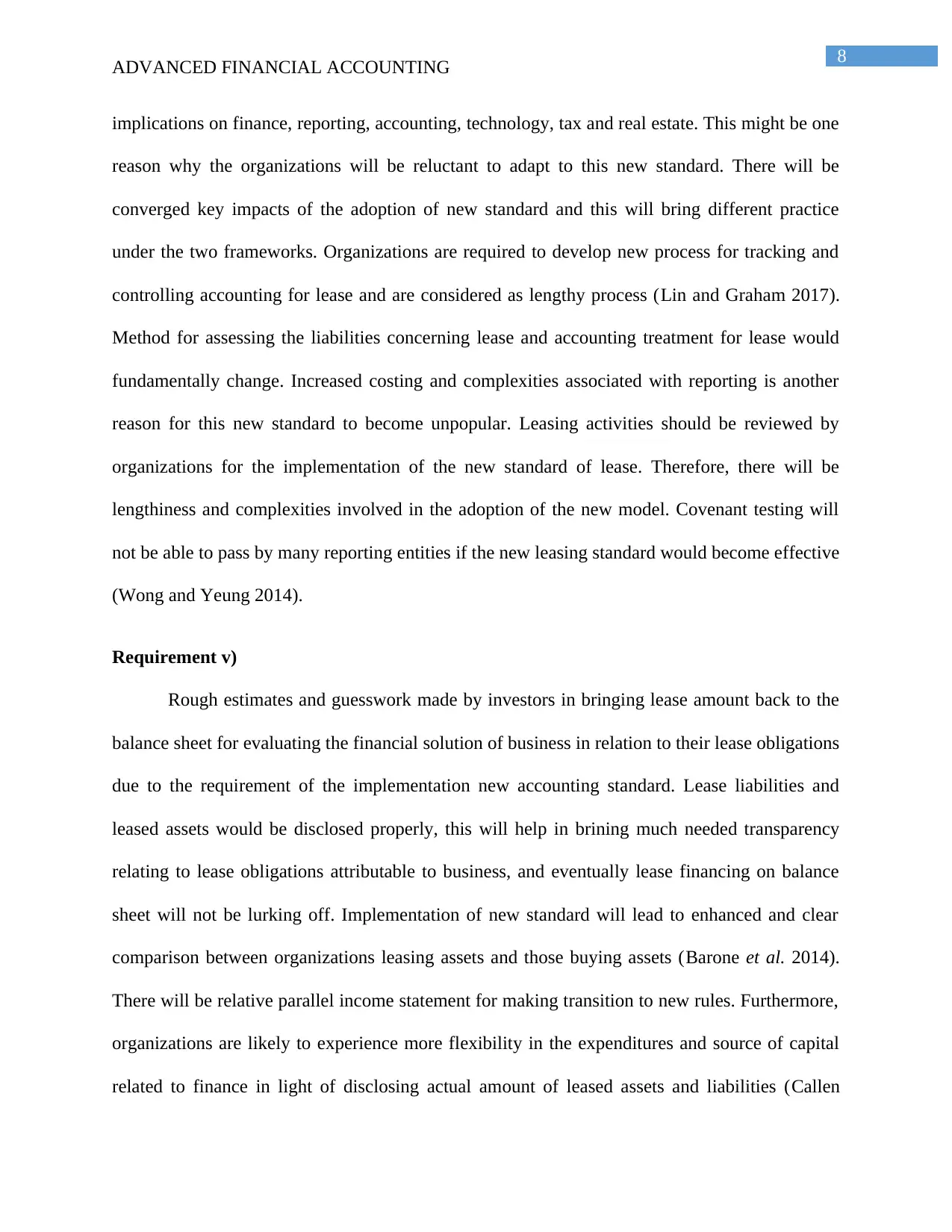
8
ADVANCED FINANCIAL ACCOUNTING
implications on finance, reporting, accounting, technology, tax and real estate. This might be one
reason why the organizations will be reluctant to adapt to this new standard. There will be
converged key impacts of the adoption of new standard and this will bring different practice
under the two frameworks. Organizations are required to develop new process for tracking and
controlling accounting for lease and are considered as lengthy process (Lin and Graham 2017).
Method for assessing the liabilities concerning lease and accounting treatment for lease would
fundamentally change. Increased costing and complexities associated with reporting is another
reason for this new standard to become unpopular. Leasing activities should be reviewed by
organizations for the implementation of the new standard of lease. Therefore, there will be
lengthiness and complexities involved in the adoption of the new model. Covenant testing will
not be able to pass by many reporting entities if the new leasing standard would become effective
(Wong and Yeung 2014).
Requirement v)
Rough estimates and guesswork made by investors in bringing lease amount back to the
balance sheet for evaluating the financial solution of business in relation to their lease obligations
due to the requirement of the implementation new accounting standard. Lease liabilities and
leased assets would be disclosed properly, this will help in brining much needed transparency
relating to lease obligations attributable to business, and eventually lease financing on balance
sheet will not be lurking off. Implementation of new standard will lead to enhanced and clear
comparison between organizations leasing assets and those buying assets (Barone et al. 2014).
There will be relative parallel income statement for making transition to new rules. Furthermore,
organizations are likely to experience more flexibility in the expenditures and source of capital
related to finance in light of disclosing actual amount of leased assets and liabilities (Callen
ADVANCED FINANCIAL ACCOUNTING
implications on finance, reporting, accounting, technology, tax and real estate. This might be one
reason why the organizations will be reluctant to adapt to this new standard. There will be
converged key impacts of the adoption of new standard and this will bring different practice
under the two frameworks. Organizations are required to develop new process for tracking and
controlling accounting for lease and are considered as lengthy process (Lin and Graham 2017).
Method for assessing the liabilities concerning lease and accounting treatment for lease would
fundamentally change. Increased costing and complexities associated with reporting is another
reason for this new standard to become unpopular. Leasing activities should be reviewed by
organizations for the implementation of the new standard of lease. Therefore, there will be
lengthiness and complexities involved in the adoption of the new model. Covenant testing will
not be able to pass by many reporting entities if the new leasing standard would become effective
(Wong and Yeung 2014).
Requirement v)
Rough estimates and guesswork made by investors in bringing lease amount back to the
balance sheet for evaluating the financial solution of business in relation to their lease obligations
due to the requirement of the implementation new accounting standard. Lease liabilities and
leased assets would be disclosed properly, this will help in brining much needed transparency
relating to lease obligations attributable to business, and eventually lease financing on balance
sheet will not be lurking off. Implementation of new standard will lead to enhanced and clear
comparison between organizations leasing assets and those buying assets (Barone et al. 2014).
There will be relative parallel income statement for making transition to new rules. Furthermore,
organizations are likely to experience more flexibility in the expenditures and source of capital
related to finance in light of disclosing actual amount of leased assets and liabilities (Callen
⊘ This is a preview!⊘
Do you want full access?
Subscribe today to unlock all pages.

Trusted by 1+ million students worldwide
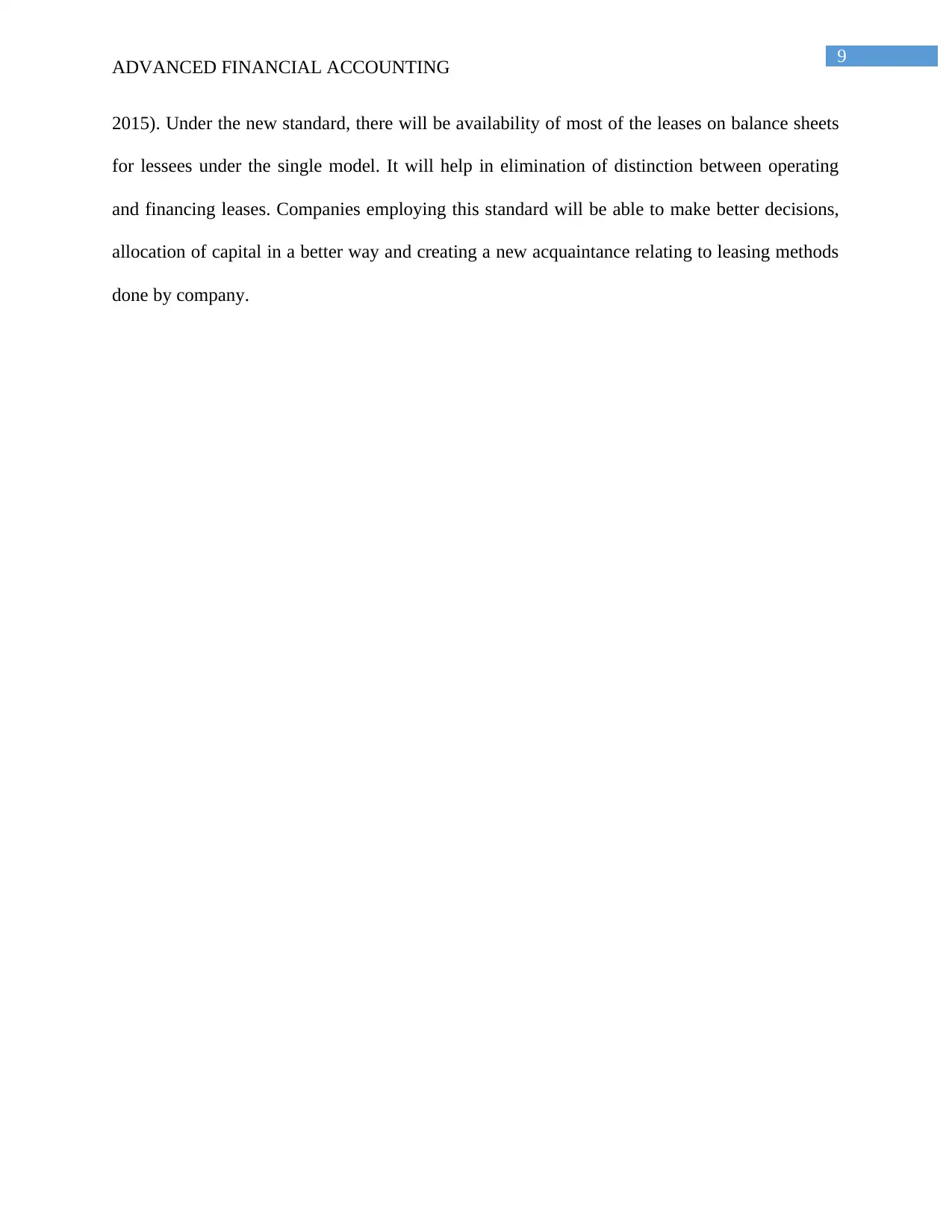
9
ADVANCED FINANCIAL ACCOUNTING
2015). Under the new standard, there will be availability of most of the leases on balance sheets
for lessees under the single model. It will help in elimination of distinction between operating
and financing leases. Companies employing this standard will be able to make better decisions,
allocation of capital in a better way and creating a new acquaintance relating to leasing methods
done by company.
ADVANCED FINANCIAL ACCOUNTING
2015). Under the new standard, there will be availability of most of the leases on balance sheets
for lessees under the single model. It will help in elimination of distinction between operating
and financing leases. Companies employing this standard will be able to make better decisions,
allocation of capital in a better way and creating a new acquaintance relating to leasing methods
done by company.
Paraphrase This Document
Need a fresh take? Get an instant paraphrase of this document with our AI Paraphraser
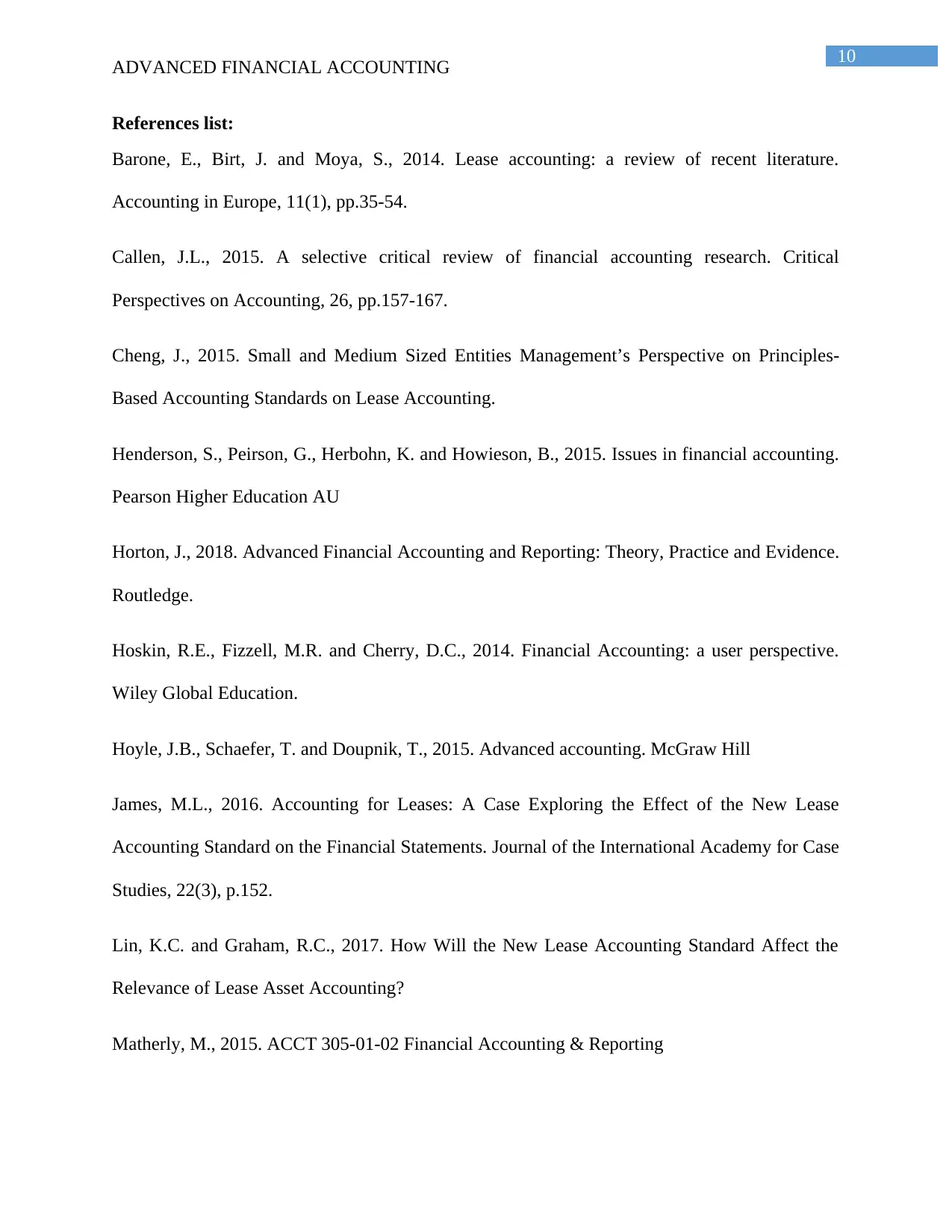
10
ADVANCED FINANCIAL ACCOUNTING
References list:
Barone, E., Birt, J. and Moya, S., 2014. Lease accounting: a review of recent literature.
Accounting in Europe, 11(1), pp.35-54.
Callen, J.L., 2015. A selective critical review of financial accounting research. Critical
Perspectives on Accounting, 26, pp.157-167.
Cheng, J., 2015. Small and Medium Sized Entities Management’s Perspective on Principles-
Based Accounting Standards on Lease Accounting.
Henderson, S., Peirson, G., Herbohn, K. and Howieson, B., 2015. Issues in financial accounting.
Pearson Higher Education AU
Horton, J., 2018. Advanced Financial Accounting and Reporting: Theory, Practice and Evidence.
Routledge.
Hoskin, R.E., Fizzell, M.R. and Cherry, D.C., 2014. Financial Accounting: a user perspective.
Wiley Global Education.
Hoyle, J.B., Schaefer, T. and Doupnik, T., 2015. Advanced accounting. McGraw Hill
James, M.L., 2016. Accounting for Leases: A Case Exploring the Effect of the New Lease
Accounting Standard on the Financial Statements. Journal of the International Academy for Case
Studies, 22(3), p.152.
Lin, K.C. and Graham, R.C., 2017. How Will the New Lease Accounting Standard Affect the
Relevance of Lease Asset Accounting?
Matherly, M., 2015. ACCT 305-01-02 Financial Accounting & Reporting
ADVANCED FINANCIAL ACCOUNTING
References list:
Barone, E., Birt, J. and Moya, S., 2014. Lease accounting: a review of recent literature.
Accounting in Europe, 11(1), pp.35-54.
Callen, J.L., 2015. A selective critical review of financial accounting research. Critical
Perspectives on Accounting, 26, pp.157-167.
Cheng, J., 2015. Small and Medium Sized Entities Management’s Perspective on Principles-
Based Accounting Standards on Lease Accounting.
Henderson, S., Peirson, G., Herbohn, K. and Howieson, B., 2015. Issues in financial accounting.
Pearson Higher Education AU
Horton, J., 2018. Advanced Financial Accounting and Reporting: Theory, Practice and Evidence.
Routledge.
Hoskin, R.E., Fizzell, M.R. and Cherry, D.C., 2014. Financial Accounting: a user perspective.
Wiley Global Education.
Hoyle, J.B., Schaefer, T. and Doupnik, T., 2015. Advanced accounting. McGraw Hill
James, M.L., 2016. Accounting for Leases: A Case Exploring the Effect of the New Lease
Accounting Standard on the Financial Statements. Journal of the International Academy for Case
Studies, 22(3), p.152.
Lin, K.C. and Graham, R.C., 2017. How Will the New Lease Accounting Standard Affect the
Relevance of Lease Asset Accounting?
Matherly, M., 2015. ACCT 305-01-02 Financial Accounting & Reporting
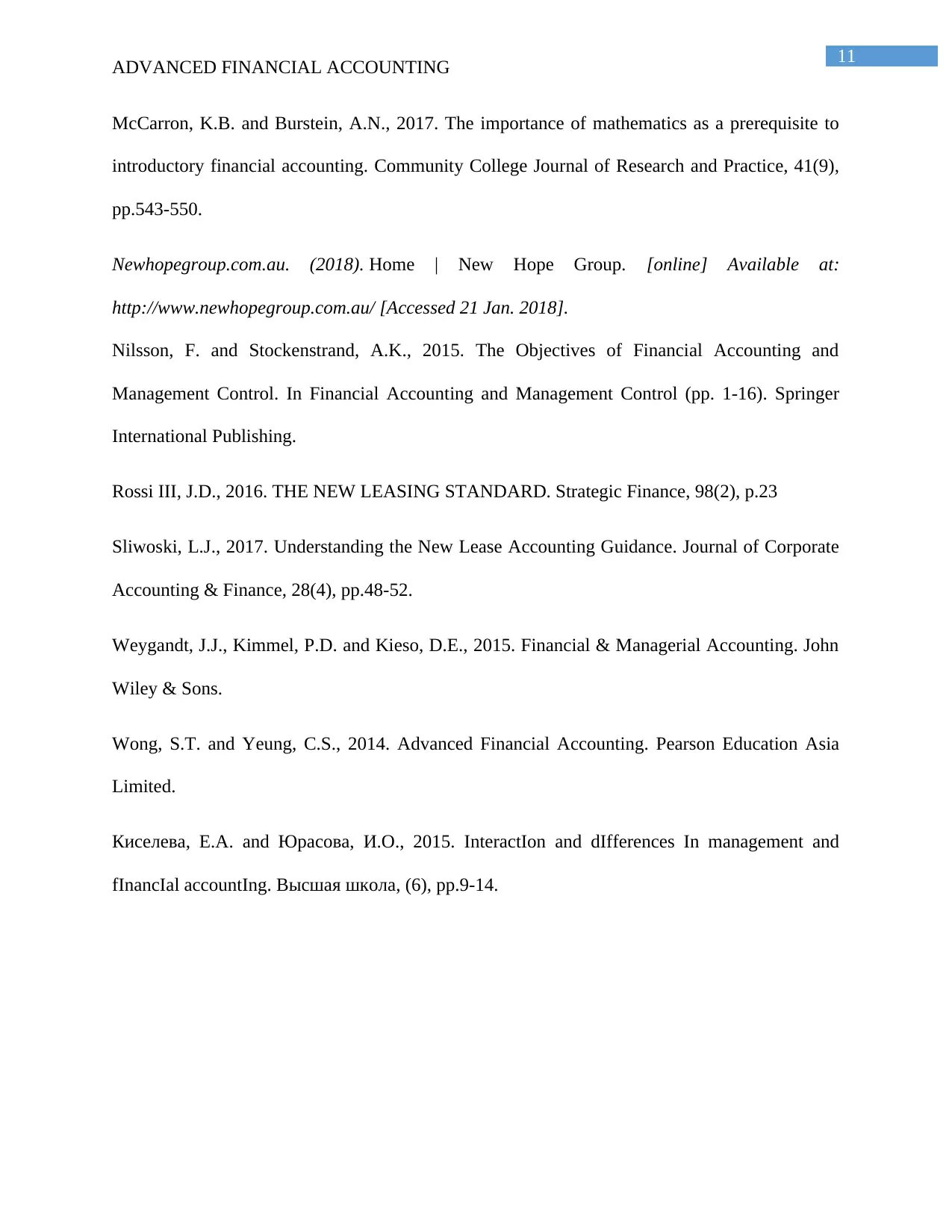
11
ADVANCED FINANCIAL ACCOUNTING
McCarron, K.B. and Burstein, A.N., 2017. The importance of mathematics as a prerequisite to
introductory financial accounting. Community College Journal of Research and Practice, 41(9),
pp.543-550.
Newhopegroup.com.au. (2018). Home | New Hope Group. [online] Available at:
http://www.newhopegroup.com.au/ [Accessed 21 Jan. 2018].
Nilsson, F. and Stockenstrand, A.K., 2015. The Objectives of Financial Accounting and
Management Control. In Financial Accounting and Management Control (pp. 1-16). Springer
International Publishing.
Rossi III, J.D., 2016. THE NEW LEASING STANDARD. Strategic Finance, 98(2), p.23
Sliwoski, L.J., 2017. Understanding the New Lease Accounting Guidance. Journal of Corporate
Accounting & Finance, 28(4), pp.48-52.
Weygandt, J.J., Kimmel, P.D. and Kieso, D.E., 2015. Financial & Managerial Accounting. John
Wiley & Sons.
Wong, S.T. and Yeung, C.S., 2014. Advanced Financial Accounting. Pearson Education Asia
Limited.
Киселева, Е.А. and Юрасова, И.О., 2015. InteractIon and dIfferences In management and
fInancIal accountIng. Высшая школа, (6), pp.9-14.
ADVANCED FINANCIAL ACCOUNTING
McCarron, K.B. and Burstein, A.N., 2017. The importance of mathematics as a prerequisite to
introductory financial accounting. Community College Journal of Research and Practice, 41(9),
pp.543-550.
Newhopegroup.com.au. (2018). Home | New Hope Group. [online] Available at:
http://www.newhopegroup.com.au/ [Accessed 21 Jan. 2018].
Nilsson, F. and Stockenstrand, A.K., 2015. The Objectives of Financial Accounting and
Management Control. In Financial Accounting and Management Control (pp. 1-16). Springer
International Publishing.
Rossi III, J.D., 2016. THE NEW LEASING STANDARD. Strategic Finance, 98(2), p.23
Sliwoski, L.J., 2017. Understanding the New Lease Accounting Guidance. Journal of Corporate
Accounting & Finance, 28(4), pp.48-52.
Weygandt, J.J., Kimmel, P.D. and Kieso, D.E., 2015. Financial & Managerial Accounting. John
Wiley & Sons.
Wong, S.T. and Yeung, C.S., 2014. Advanced Financial Accounting. Pearson Education Asia
Limited.
Киселева, Е.А. and Юрасова, И.О., 2015. InteractIon and dIfferences In management and
fInancIal accountIng. Высшая школа, (6), pp.9-14.
⊘ This is a preview!⊘
Do you want full access?
Subscribe today to unlock all pages.

Trusted by 1+ million students worldwide
1 out of 12
Related Documents
Your All-in-One AI-Powered Toolkit for Academic Success.
+13062052269
info@desklib.com
Available 24*7 on WhatsApp / Email
![[object Object]](/_next/static/media/star-bottom.7253800d.svg)
Unlock your academic potential
Copyright © 2020–2025 A2Z Services. All Rights Reserved. Developed and managed by ZUCOL.





